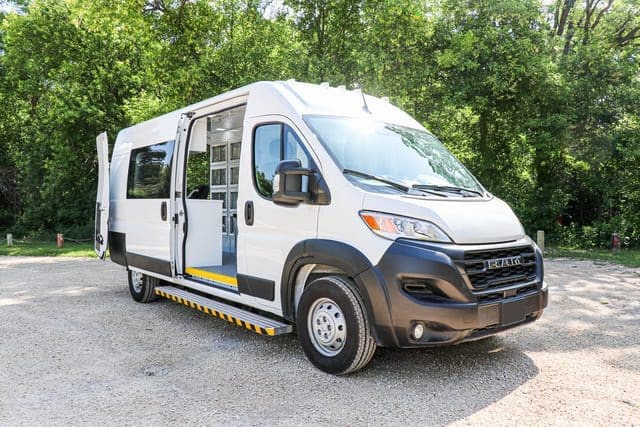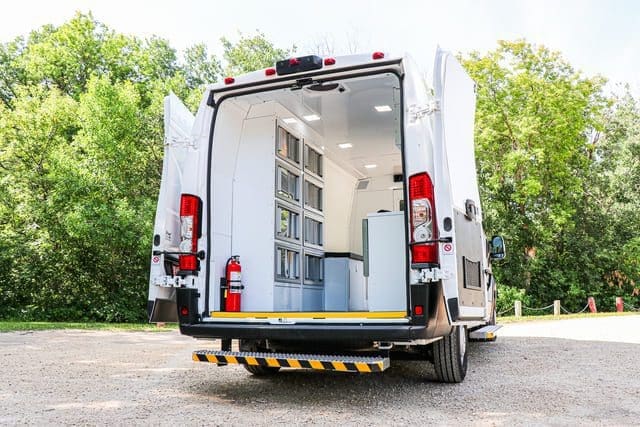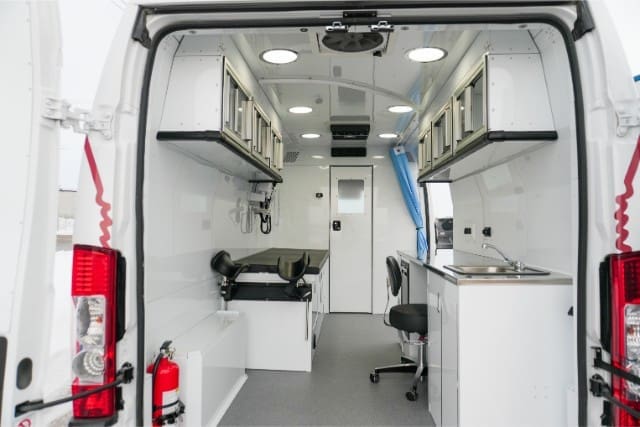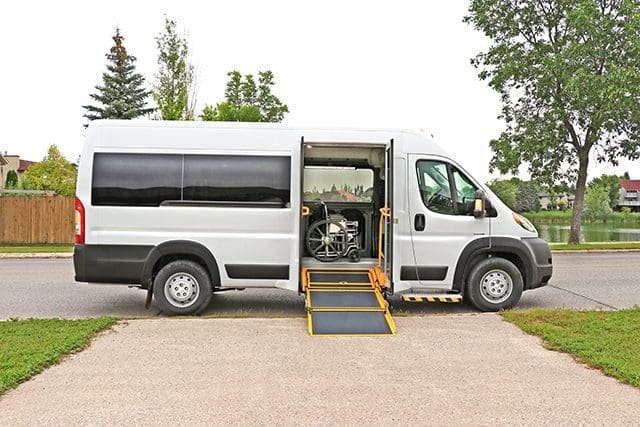Is your organization currently trying to decide between mobile medical buses vs. mobile medical vans? There are many differences between these two vehicles. There are also some similarities to keep in mind, as well.
The wrong vehicle could mean navigation issues through various terrains or locations, restricting your reach to remote communities. Making the wrong choice can also affect the long-term affordability of the mobile medical vehicle.
At MoveMobility, our decade of experience has consistently reminded us that customers are happier and make better choices when companies are transparent about what they offer. Even if you don’t choose one of our vehicles, we’re satisfied if you’re satisfied with your purchase decision.
In this article, you’re going to learn about the differences and similarities between mobile medical buses vs. mobile medical vans. We hope this article will give you some insight into which one will work best for your organization.
What are the differences between mobile medical buses vs. mobile medical vans?
Have you ever wondered about the wheels that power healthcare on the go? When it comes to mobile medical units, the choice between a bus and a van is more than just size. Let’s take a closer look at the differences between these vehicles.
1. Size
One of the most noticeable differences between mobile medical buses and vans is their size. Mobile medical vans are smaller. This makes them nimble navigators through bustling city streets and remote corners of Canada.
On the flip side, mobile medical buses have more interior room. This provides a spacious environment for comprehensive healthcare services.
Some mobile medical buses are 38 feet in length. Mobile medical vans are just over 13 feet long. When you’re driving in areas with tight corners, gravel roads, or bustling cities, navigating a 38-foot vehicle can be challenging.
2. License to drive
Operating a mobile medical bus requires a commercial driver’s license. This adds a layer of complexity to the staffing requirements.
Most mobile medical vans, however, don’t require a commercial driver’s license for operation. In the majority of Canadian provinces, aside from B.C., you can operate a mobile medical van with a standard driver’s license.
3. Costs
Another difference that’s hard to ignore is the cost between a mobile medical van and a mobile medical bus.
Mobile medical buses can be 2-3 times pricier than vans. They also have higher operational costs. That means your organization will be spending more on maintenance over the long term.
Mobile medical vans are a more budget-friendly option. They have lower maintenance costs due to utilizing the original chassis and body designed by the manufacturer.
4. Capacity
Mobile medical vans generally have a lower occupancy capacity than buses. The lower occupancy isn’t something that should be seen in a negative light. It tends to create a more personalized setting for healthcare interactions.
Mobile medical buses, on the other hand, can accommodate larger amounts of people at the same time. The larger buses can fit multiple exam rooms, meaning that more numerous patients can be seen at the same time.
5. Conversion times
Thanks to their smaller size, mobile medical vans undergo a faster conversion process, making them available for service promptly. The time it takes to receive your mobile medical van ranges between 4 and 6 months.
Larger mobile medical bus unit conversions can take up to two years to complete. This requires more time and meticulous planning from your organization. Not every organization has two years to wait for their mobile medical vehicle to be fully ready for service.
6. Customization options
The sheer size of mobile medical buses might offer a bit more design flexibility. When you have more room to work with, it allows for intricate customization based on your specific healthcare requirements. For example, if you need five X-ray machines, you’re going to need the space to store them in the vehicle.
However, excess room can also make things more complicated. For example, more space means you have to move further around the interior of the vehicle to reach medical equipment. In addition, a larger space means you have more areas to monitor and maintain.
Mobile medical vans are still highly customizable and you’d be surprised by what you can do when you have a team of skilled engineers making the most of every inch of space.
7. Fuel efficiency
Vans are smaller than buses and have better fuel efficiency. This is important if your organization is focused on contributing to a greener and more sustainable approach.
Buses, being larger, tend to consume a lot more fuel, impacting both operational costs and environmental factors.
8. Services
Mobile medical vans are great for specialized healthcare needs in both remote locations and cities. They can focus on very specific services like:
- Mental health
- Helping the homeless
- Substance abuse
- Health screening
- Education
Buses are similar to moving healthcare centers. They have more room, so they can offer many medical services at once.
Now that we’ve covered a few of the differences between mobile medical buses vs. mobile medical vans, let’s take a look at some of their similarities.
What are the similarities between mobile medical buses vs. mobile medical vans?

While it might seem like mobile medical buses and mobile medical vans have a lot of differences, they also have a lot in common. Keep reading to learn about some of their similarities.
1. Both provide healthcare
Both mobile medical buses and vans have the same important job. They’re all about taking medical care to different places in Canada. They act like moving health centers, making sure that everyone, no matter where they are, can get the medical help they need.
It doesn’t matter if someone is 95 years old with mobility issues or someone who simply doesn’t have a car to get to a hospital. These vehicles provide high-quality healthcare to those who need it.
2. Breaking barriers
These vehicles break down barriers by going to neighborhoods and communities that don’t have many healthcare options. They break down barriers like:
- Stigma
- Transportation
- Location
- Mental health
- Cultural differences
3. Private spaces
Sometimes, people don’t want others to know about their health problems, like using drugs. Mobile medical vans offer a bit more privacy, but both buses and vans give people a private space to get help. This is important, especially when the only other alternative is a busy and crowded hospital where people may place judgment on others.
4. Customizable care
Both mobile medical buses and vans can change to fit the healthcare needs of each community. They can offer different kinds of care, like health screening or vaccinations. This makes them flexible and able to help different communities in the best way possible.
5. Education
Mobile medical vans and buses provide more than just medical help. Your organization can use them to teach communities about staying healthy. You can have workshops and share information to help people live better and know more about taking care of themselves.
6. Fast help in emergencies
In emergencies, mobile medical buses and vans can move quickly to provide medical help. Whether it’s a sudden problem, a natural disaster, or just someone needing urgent care, these vehicles are ready to help quickly.
Mobile medical buses vs. mobile medical vans: What should you choose?
Now, the big question: which one should you choose – a mobile medical bus or a mobile medical van? Well, it depends on what your healthcare mission aims to achieve. Let’s take a look at a few scenarios where vans or buses might work better for your organization.
If you’re planning to bring healthcare to remote locations or navigating busy city streets where maneuverability is key, a mobile medical van is your best bet. These compact and nimble vehicles can easily navigate through tight spaces, ensuring you can reach the heart of communities without compromise.
If your organization is watching the budget closely, mobile medical vans are a wise option. They not only cost less to purchase but also require lower maintenance, making them a financially feasible choice for organizations that are mindful of their resources. If you’re piloting a program and don’t want to invest hundreds of thousands of dollars in a bus, a van is a more cost-effective way to test the waters.
However, if your organization is ready to dive into a large-scale mobile medical initiative and needs plenty of space for various healthcare services, along with the time to wait for it to be manufactured and the money to invest, then a mobile medical bus becomes a more suitable option. With the extra room, these buses offer a versatile platform to deliver an extensive array of healthcare programs.
Ultimately, the choice between a mobile medical bus and a van is like picking the right tool for the job. Consider the goals of your mobile healthcare initiative, the locations you’ll be serving, your budget constraints, and the scale of services you plan to provide.
When you align your choice with your organization’s specific needs and objectives, you’ll ensure that your mobile medical unit becomes a force in breaking barriers and delivering essential healthcare services to those who need them most.
Where to go next with MoveMobility

You most likely landed on this article while trying to decide if mobile medical buses or mobile medical vans will work better for your organization.
You learned about the differences and similarities of these vehicles, and we hope we left you with some valuable information to think about further.
At MoveMobilty, we have four different types of mobile medical vans that organizations all over Canada use for a variety of purposes. If you’re interested in learning more about them, click the button at the end of this article to talk to an expert.
Or, you can also read through our article that talks about the types of mobile medical vans we offer.
Many of our clients also benefit from reading our guide on the steps to buying a mobile medical van. This article will help you understand a bit more about what’s involved in purchasing one for your organization.







